Budapest is probably one of the most breathtaking cities in Europe.
Hungary’s capital has something for everyone: from dazzling architecture to healing thermal springs and urban nightlife.
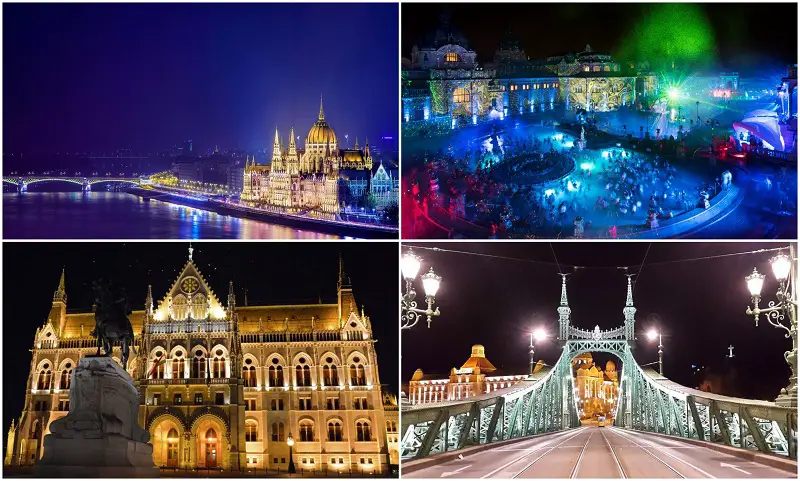
And if you are here at night, don’t worry, there are plenty of things you can do.
Here are 18 suggestions.
1/ Danube Promenade & River
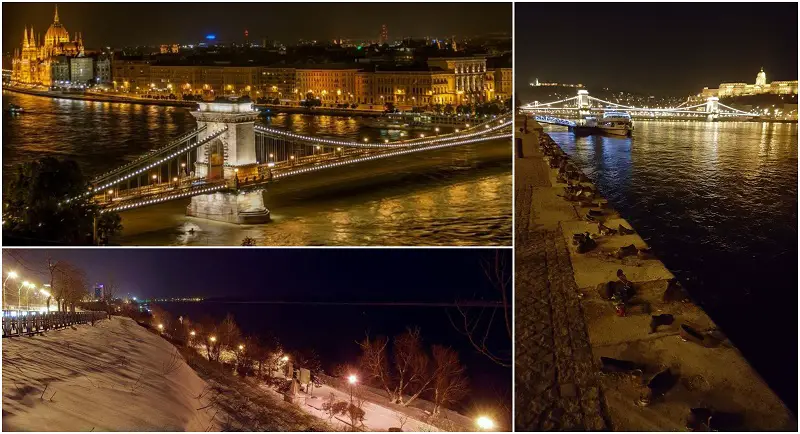
Danube river once separated two places, Buda and Pest, which are now part of the same city.
A night stroll along the Danube Promenade is a great way to enjoy some of the best parts of the city.
On the Promenade side are many interesting sculptures and the memorial Shoes on the Danube Bank, and looking over to Buda side of the river you can see Buda Castle, the Fisherman’s Bastion and Gelert Hill.
Also, Danube is considered to be one of the best rivers to cruise down at night, whether you are looking for something relaxing or romantic.
2/ Gellert Hill
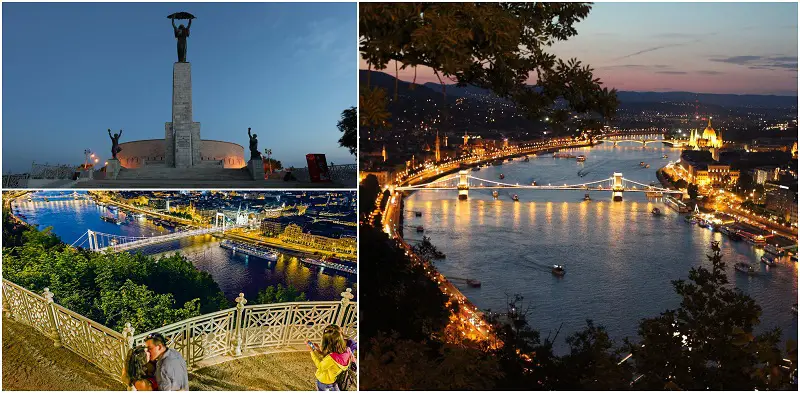
Head to the top of Gelert Hill, one of the most romantic places in Budapest.
Amazing panoramic views of the city will help make the walk well worth it.
You can enjoy them by yourself, or with your significant other.
At the top, you can also see the Liberty Monument, the lady holding the palm in her outstretched arms.
She was the tribute to the Soviet soldiers who died liberating Budapest in WWII.
However, public sentiment towards the Russian decreased, and the inscription on the monument was modified.
The area has been a UNESCO World Heritage site.
3/ Gellert Thermal Bath and Spa
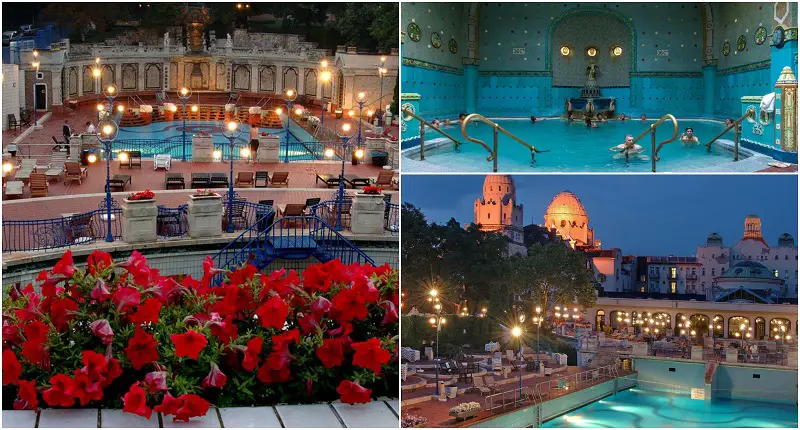
Visiting a bath is a must if you are in Budapest.
Gellert Thermal Bath is undoubtedly the most prestigious one.
The elegant spa complex was built over a century ago in Art-Nouveau style.
The spa is famous for its spectacular interior including the main hall with a gallery, glass roof and colourful ceramic tiles.
Numerous thermal pools contain water with therapeutic properties coming from Gellert Hill’s mineral hot springs.
Enjoy massage treatments, saunas, relax by the geothermal pools and have fun at the outdoor wave pool.
It’s open all year round til 8 pm, even on public holidays.
4/ Szechenyi Baths
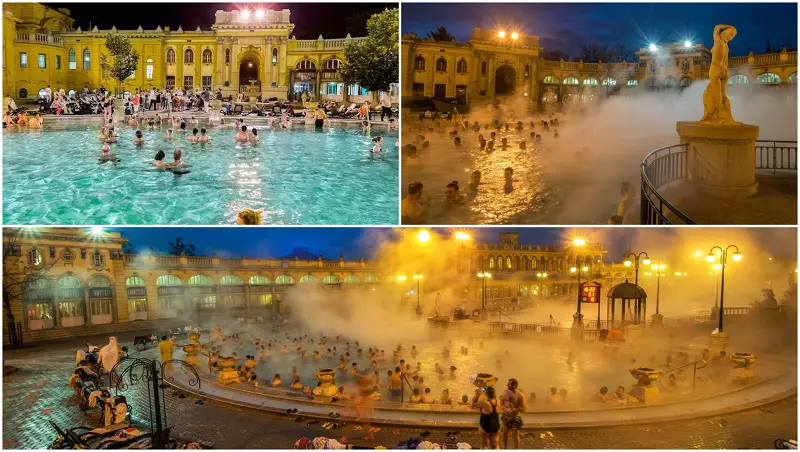
Szechenyi is probably the largest bath complex in Europe, and one of the much-praised attraction in Budapest.
It has 18 pools of various temperature, containing water with therapeutic characteristics.
It was the first bathhouse in Pest, opened in 1913, and named after Hungarian politician and writer Istvan Szechenyi.
Enjoy a detoxicating sauna or a steam room, soak in thermal spring pool, or take a few laps in the swimming pools.
Check out the outdoor pools, especially if it’s colder, and watch as the steam rises from the hot water, making the whole place look magical.
Szechenyi Baths are open daily til 10 pm.
5/ Vaci Street
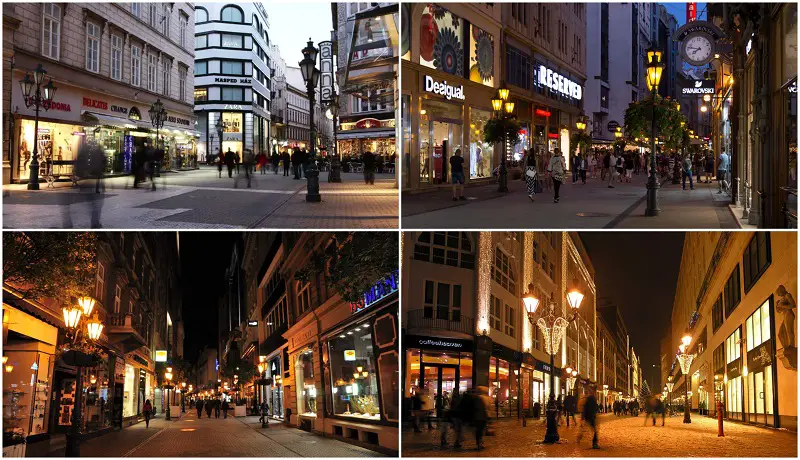
Vaci street is one of the world’s most attractive pedestrian shopping streets and the most famous street in Budapest.
You can shop at exclusive designer stores, buy souvenirs or visit wine shops.
There are also a lot of restaurants, cafes, and bars, but keep in mind that most of them are overpriced.
However, some of them are open until midnight.
The street starts at Vorosmarty Square and ends opposite the Central Market Hall.
If you don’t like shopping, stroll along Vaci utca and enjoy its polished look and architecture.
Look upwards and admire the facades of the buildings.
There are also a couple of romantic squares with statues.
6/ Hungarian State Opera House

In Hungarian State Opera House you can enjoy not just opera, but also musicals, ballet shows, plays, and other cultural highlights.
It’s a lavish building, richly decorated with grand foyer and broad staircases.
Because of its beauty and acoustics, it is considered to be one of the most beautiful opera houses in the world.
The auditorium holds more than 1200 seats, and it is well worth to buy a ticket for a show.
The season lasts from September to the end of June.
7/ St Stephen’s Basilica
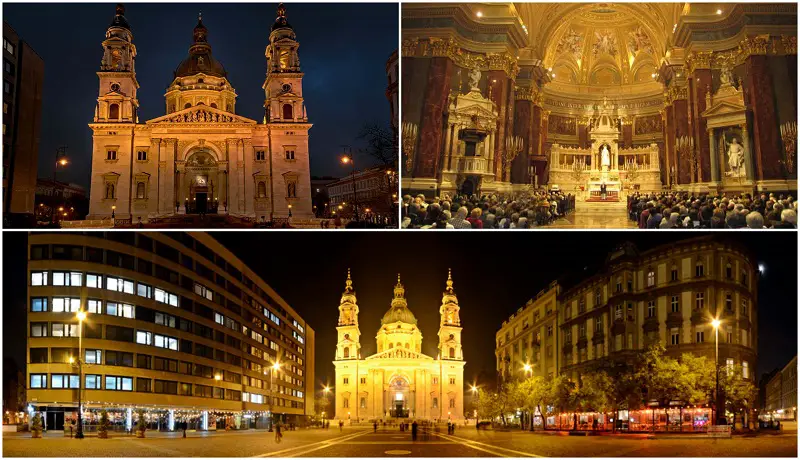
St Stephen’s Basilica is named after the first King of Hungary, Stephen (Istvan).
In the reliquary, you can find a mummified right hand that is supposedly his.
Inside the Basilica you can enjoy classical music and organ concerts.
Head to the 96-meter-high observation deck for a fantastic panoramic view of the city.
The church is free to enter, but you have to pay to climb up to the deck.
Reportedly, current legislation forbids buildings to be higher than St Stephen’s Basilica and Parliament so nothing can block your view.
At night, it is well lit by surrounding lights and provides a brilliant backdrop for photographers.
8/ Heroes’ Square

Heroes’ Square is the largest square in Budapest, and probably one of the most photographed and most visited sights in the city.
Behind it, Budapest City Park stretches with its lake and Vajdahunyad Castle.
The Square features an impressive semi-circular statue complex.
The 36-metres high Millennium Monument is in the middle.
Archangel Gabriel stands on top of the centre pillar, holding the Hungarian crown and a cross.
At the base are seven chieftains who led the Magyar tribes to Hungary, and the 14 statues in the colonnades behind are the rulers and other prominent historical figures.
9/ Castle Hill
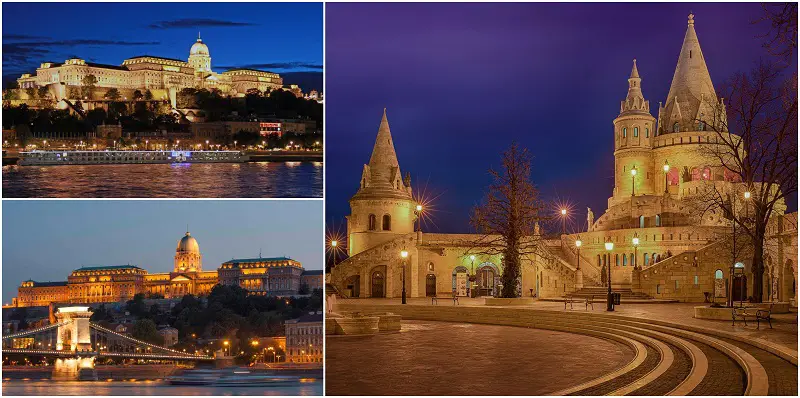
Castle Hill consists of two parts, the Old Town to the north and the Royal Palace to the south.
Here you can find some of Budapest’s most important medieval monuments and museums.
Steep, twisting streets are watched over by a mythical golden eagle featured in Hungarian mythology.
Beneath, stretches a labyrinth of caves, tunnels and cellars, including a wine cellar.
Don’t miss riding the funicular railway from Chain Bridge to Castle Hill.
It runs every day until 10 pm.
The views of the Danube alone are worth the trip, and the Royal Palace looks magical in the evening.
10/ Budapest Parliament

The Westminster Palace in London was partly the inspiration for the Parliament building.
It sits on the banks of Danube and has more than 600 rooms, but you only get to see several on a guided tour.
Although it closes at 6 pm the latest, and visits are restricted during the week, you can enjoy its eclectic architecture from the outside at any time.
The best view of the 96-metre high building is from the Danube river or the opposite Buda banks.
11/ Fisherman’s Bastion

Situated on the Castle Hill, Fisherman’s Bastion isn’t a building so much as a wall.
T-shaped bastion was built to replace the former castle wall, and it wraps around Matthias Church.
Its seven turrets represent the seven Hungarian tribes.
The legend says it got its name after fisherman who defended the bastion in times of war and conflict.
It provides an excellent vantage point, and the panoramic view over the river and across the Pest is breathtaking.
It’s open all year round, day and night until 11 pm.
There is a fee for the lookout at the top turrets, but you can enter the lower level lookout for free.
12/ Chain Bridge

Go to the Chain Bridge at night, when it’s fully illuminated, to take some fantastic photos.
It was the first bridge that connected Buda and Pest, and the first permanent bridge across the Danube in Hungary.
The 375-meter-long suspension bridge is proudly guarded by its lions.
It was opened in 1849, and at that time, regarded as one of the engineering wonders.
It is commonly known as the Chain Bridge but named in honour of Istvan Szechenyi, a major supporter of its construction.
13/ Central Market Hall
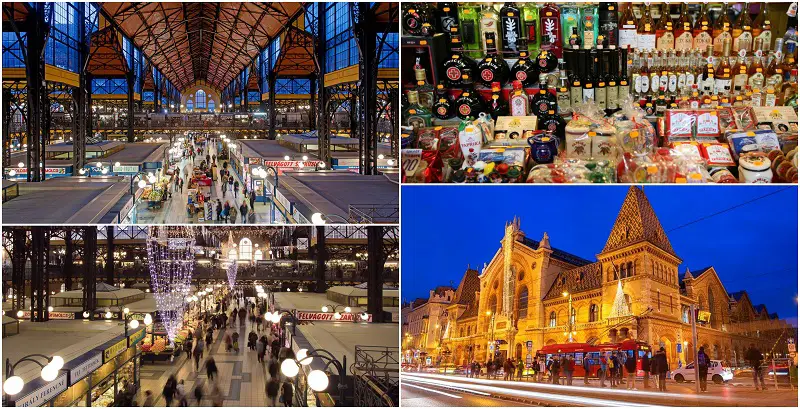
If you don’t arrive too late, check out the Central Market Hall.
This huge indoor market, popular with locals as well as the tourists, is open from Monday to Saturday, until 6 pm the latest.
The building is more than 100 years old with the roof covered in colourful tiles.
Here you can find homemade local delicacies like goulash and langos, locally grown fruit, vegetables, meat, and cheeses, and also souvenirs like leather goods.
Don’t forget to pick up some spices and wine at low prices. This market hall often holds events featuring the cuisine of foreign countries.
14/ Andrassy Avenue

Andrassy Avenue links Erzsébet Square with the Heroes’ Square and City Park.
If you want to know what Budapest life was like in the 19th century, stroll down the boulevard.
It was listed as a UNESCO World Heritage site in 2002, along with Heroes’ Square, due to its fascinating cultural heritage.
You can admire different architectural styles of mansions, townhouses and national embassies.
Hungarians didn’t want to risk public transport sullied the surrounding, so they created the Millennium Underground system, one of the oldest underground railway in the world.
15/ Gozsdu Courtyard

Gozsdu Courtyard (Udvar) consists of several buildings and their courtyards.
Built in the early 20th century, buildings became a part of the Jewish ghetto with thousands of Jews incarcerated here during WWII.
However, it was beautifully restored and became a favourite place for a night out.
Today, it is packed with pubs, bars and restaurants featuring international cuisines.
Popular with locals, this place comes alive every evening.
Also, Gozsdu Courtyard and surrounding streets inspired many film directors to shoot scenes here.
16/ Citadella

The Citadella is a 19th-century fortification on the top of the Gellert Hill.
Hungarians were forced to build it, after the Hungarian Revolution of 1848.
When it was finished, Austrian troops settled in the citadel and used it to control Hungarians fighting for independence.
Because of that, it was despised by the locals.
However, in the 1960s the Citadella was transformed into a tourist centre.
Its 60 canon placements remain, as do the six-meter walls of the fort.
It features one of the best lookouts of Budapest.
17/ Danube Palace

The Danube Palace (Duna Palota) was built in the late 19th century, as a part of Budapest Millennium Celebration in 1896.
The Habsburg Emperor Franc Joseph I was determined to create a prestigious city, so Budapest underwent a massive expansion.
Initially, the Duna Palota was a casino but built rather for the entertainment of the aristocratic men than gambling.
The Palace has several elegant salons perfect for filming, such as the Brown Salon, where one scene of the Evita (starring Madonna) was filmed.
Most Hungarian folk dance shows take place here, and the Danube Palace is also home to the Danube Symphony Orchestra.
It hosts a variety of literary and artistic events too.
18/ Buda Castle

The Buda Castle watches over the city from the top of the Castle Hill, and it was the complex of the Hungarian kings.
It was destroyed, and then rebuilt a couple of times.
Except for the Buda Castle (formerly Royal Palace), the complex is home to National Gallery and the Budapest History Museum.
The gardens offer sweeping views of the Danube and the city.
The castle interior is open Tuesday – Sunday 10am-6pm.
However, you can always spend the evening exploring the exterior of the Buda castle at night, while listening to gruesome historical facts of Hungarian history, as well as the myths of Vlad Dracula.
Check Tour More Buda Castle Tours
As you can see, you won’t be bored if you arrive late to Budapest.
There is a wide range of activities from classical concerts to thermal spas, so you should be able to find something that suits you.
Use the time you have on your disposal and enjoy the city that many tourists consider to be among the most beautiful in Europe.
More Things to do in Budapest at Night











